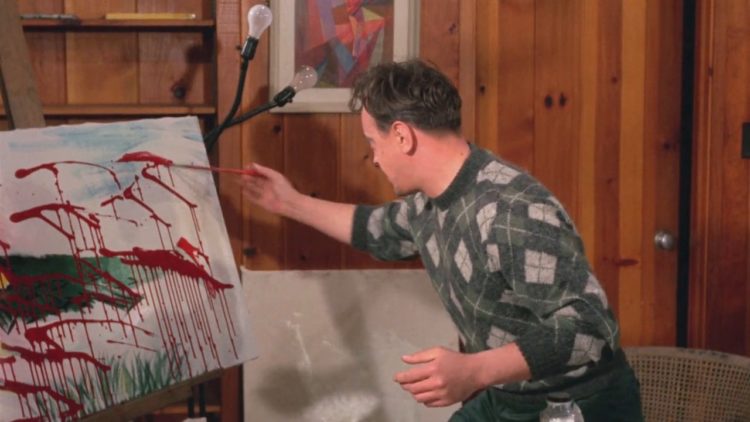
As noted by Clive Davies in his book Spinegrinder: The Movies Most Critics Won’t Write About, Herschell Gordon Lewis’ 1965 film, Color Me Blood Red, “is kind of an extension of A Bucket of Blood,” directed by Roger Corman in 1959. While the former is a brightly-colored, slightly serious picture, and the latter a black-and-white laugh riot, the films do share quite a few details. They’re both about frustrated artists who turn to murder in order to find greater success. Both find their inspiration via accident, and are eventually discovered due to sloppy corpse disposal.

A Bucket of Blood is, per Wikipedia, about a “dimwitted, impressionable young busboy at a Bohemian café who is acclaimed as a brilliant sculptor when he accidentally kills his landlady’s cat and covers its body in clay to hide the evidence. When he is pressured to create similar work, he becomes murderous,” whereas Color Me Blood Red is about “a psychotic painter who murders civilians and uses their blood as red paint.”
Really, aside from the particulars, they’re basically the same movie, differing only in who stars in them, and the tone: Corman’s film stars Dick Miller as Walter Paisley, and Gordon Oas-Heim is Adam Sorg in Lewis’ movie. Paisley’s a little less likeable than Sorg, at least at first, and A Bucket of Blood is intentionally funny, rather than Color Me Blood Red’s accidental laughs.

The two movies present a really solid glimpse at drive-in fare from the late ‘50s and early ‘60s, and they’re both an absolute blast. Each film was made on a shoestring budget of roughly $50,000, which wasn’t much at all, even fifty years ago, but the verve and vision of the two directors lend each movie a sort of “we can do it!” charm, even when the seams begin to show.
In “Blood Perspectives,” a bonus feature for Arrow Video’s Blu-ray release of Lewis’ Blood Feast, director Rodney Ascher (Room 237) says something which is readily applicable to both of the films we’re suggesting:
“When I was in high school and first exploring these movies, there was just something kind of cathartic about exposing yourself to the most outrageous ends of movies. You might put in the context of, oh, I don’t know — dada and surreal art. Certainly, there’s a sort of dream logic that occurs in these films. I think, now what I find interesting is the way a lot of them play as kind of accidental documentaries. You get this amazing little time capsule, because they don’t have a huge budget for set construction and art direction. They don’t change anything. So, between the cracks of the story, there’s all this other stuff.”
It’s a point continued and filled out by fellow director Nicholas McCarthy (The Pact):
“You get something that you don’t normally get in movies that have money or real stars: a kind of record. A real world record of a person who isn’t a Hollywood producer and is using what we might regard as ‘real people’ as actors, probably wearing the clothes that they found in their closet that morning and shooting in a store down the street that he knew the owner, and this is now preserved for all eternity.”

While both A Bucket of Blood and Color Me Blood Red have a lot of weird special effects and strange perspective on the art world, Corman’s film is a little more highly-regarded. VideoHound’s Guide to Cult Flicks and Trash Pics describes A Bucket of Blood as being “worthless as a horror film, but priceless as a hip black comedy that satirizes the beatnik coffeehouse scene.”
The Videohound guide looks at Color Me Blood Red a little less spectacularly, saying that “This is less bloody and less interesting than the other two, and the satirical jabs at the art world go nowhere,” in reference to the fact that Color Me Blood Red is the final film of Lewis’ Blood Trilogy, which began with Blood Feast and continued in 2000 Maniacs.
While lacking a bit of the scenery-chewing verve of Maniacs and the out-and-out weirdness of Blood Feast, the film still has a lot to recommend it. Cult Flicks and Trash Pics may disagree, but it really seems that the same points are being made in Lewis’ film as in Corman’s: namely, art critics are ridiculously pretentious, and artists are homicidal maniacs just waiting for an excuse to spill blood.
Maybe it’s that A Bucket of Blood did it first, and that Color Me Blood Red doesn’t cut quite as deeply because it’s six years later, but given that the art world will always be full of pretentious jerks acting as gatekeepers, one would think that Lewis’ film — which deals more with the art world in particular, rather than Corman’s beatnik coffeehouse scene — would hold up better. Art critics and gallery owners are still portrayed as snooty jerks with upturned noses, whereas the beatnik scene was a hackneyed, tired gag by the time Maynard G. Krebs popped up on Doby Gillis.

All that said, A Bucket of Blood and Color Me Blood Red both make some clever allusions regarding the artistic impulse and the killer instinct, and when paired together, only become more pointed in their attack. They’re both readily available, so you can watch them pretty easily. Color Me Blood Red was released on Blu-ray from Something Weird, but isn’t currently available for streaming, whereas A Bucket of Blood can be watched for free below, because it’s public domain. It’s worth dropping the $10 for Lewis’ Blood Trilogy, though.




